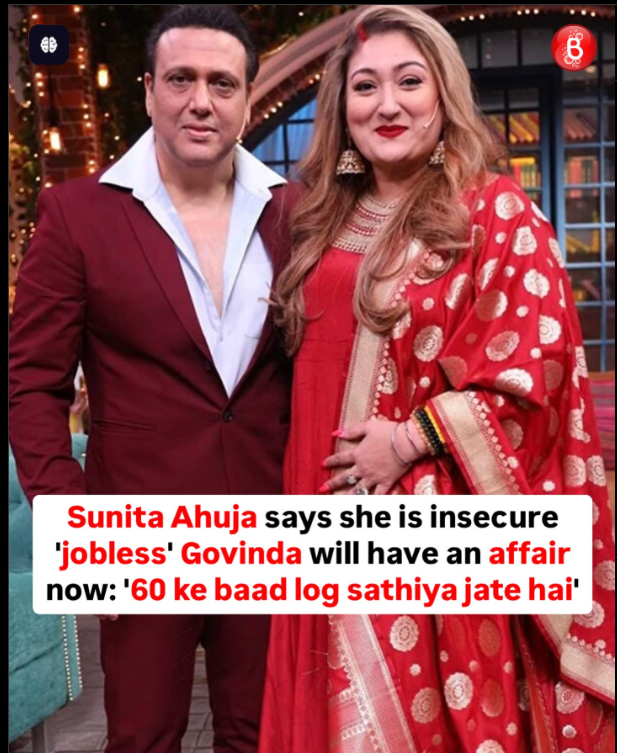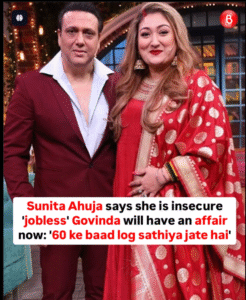
The Biwi vs. The Maestro: Unpacking the ‘Cheap Copy’ Controversy Between Sunita Ahuja and Farah Khan
In an era where the meticulously curated public image of a celebrity is being replaced by a demand for unfiltered, “authentic” digital content, a new front has opened for Bollywood’s extended families. Once relegated to the periphery, “star-wives” are now stepping into the spotlight, carving out their own digital identities and streams of revenue. This tectonic shift, however, is not without its challenges, as evidenced by the recent controversy surrounding Sunita Ahuja, the wife of veteran actor Govinda. Her foray into the world of vlogging ignited a viral storm, centered on a single, potent accusation: that she is merely a “cheap copy” of acclaimed filmmaker and choreographer Farah Khan.
This report delves beyond the superficiality of a viral headline to deconstruct the underlying narrative. It argues that while the initial comparison was rooted in observable similarities in content format, the public’s subsequent reaction was a complex cultural judgment. It was a commentary on the distinct pre-existing brands of both women, the perceived motive behind their creative ventures, and the paradoxical scrutiny of what is deemed “authentic” in the digital age. This is not simply a story of imitation; it is a case study in the evolving role of Bollywood’s biwis and the commodification of personality in a rapidly changing media landscape.
The New Vlogging Frontier: An Anatomy of a Debut
https://www.instagram.com/reel/DAnEOVZMOAq/

Sunita Ahuja’s entrance into the digital space was as audacious as her public persona. On Independence Day, August 15, 2025, she launched her YouTube channel, a move that immediately captured the internet’s attention. The launch was met with remarkable initial success, amassing over 42,000 subscribers in just 22 hours and a debut video that crossed half a million views within a day. The title of her first vlog, a bold and declarative “Aab Mein Paise Chapugi” (Now, I will mint some money), set a no-nonsense tone, framing her new venture not as a creative indulgence but as a direct, unapologetic business move.
The content of the vlog itself was a raw and highly personal “day-in-the-life” journey. A central element was the prominent featuring of her staff member, Mukesh, who accompanied her on a travel pilgrimage. Mukesh was quickly labeled by the media and internet users as her version of Farah Khan’s beloved cook, Dilip, a comparison that would become the central point of contention. Throughout the video, Sunita shared a number of emotional and unfiltered moments. She broke down in a temple while praying for the wellbeing of her marriage and family, directly addressing what she called a “difficult year” and the people who had spoken “nonsense” about her. This candidness, a hallmark of her public image, was also on display when she purchased alcohol for a religious offering, preemptively clarifying her actions to counter any potential judgment.
The choice of this specific format, with a celebrity and their long-time staff member, is a proven strategy for generating “relatable” digital content. Creators who use this model seek to break down the highly polished celebrity facade, offering a seemingly unscripted, genuine look into their lives. The success of this approach hinges on the perceived authenticity of the bond between the celebrity and their staff. Sunita’s adoption of this blueprint was an attempt to replicate the success of the model, but the immediate and negative reaction demonstrated a critical public judgment. The accusation of being a “cheap copy” suggests a perceived failure to capture the genuine, organic chemistry that defines the original. This critique implies that Sunita’s attempt was a calculated, low-quality imitation, lacking the crucial ingredient of a true connection and therefore feeling less authentic.
The Original Blueprint: The Farah Khan Formula for Digital Stardom
To understand the critique leveled against Sunita Ahuja, it is essential to first establish the undisputed brand of her counterpart, Farah Khan. Unlike Sunita, who is primarily known for her role as a celebrity spouse, Farah Khan is a self-made professional with a long and illustrious career. She is a celebrated filmmaker and choreographer, an industry “maestro” who has won a National Film Award and multiple Filmfare Awards for her work on over a hundred songs in eighty films, as well as several international projects. Her professional gravitas and witty public persona lend an immediate air of authority and originality to her work, whether on the big screen or the small screen.
Farah’s digital success is built on her weekly vlogs with her cook, Dilip, which have been widely celebrated as a “beloved web series” and a “fan favourite”. The central dynamic is an effortless, lighthearted banter between the two that has made Dilip a celebrity in his own right, garnering him a dedicated fan base and even paid brand endorsements. The content is typically centered on cooking, but it is the unscripted, fun conversations with a rotating cast of celebrity guests that makes the series so engaging. A critical aspect of Farah’s narrative is her explicit transparency regarding her professional relationship with Dilip. In a vlog, she revealed that she pays him a substantial amount for his appearances, a detail that reinforces a narrative of mutual respect and generosity.
The success of Farah’s vlogs is tied directly to her pre-existing brand. They are not perceived as a calculated career move but as a natural, fun extension of her life. Her established credibility and the public knowledge of her professional achievements mean her new venture is seen as a side project rather than a bid for fame. The fact that she is seen to be a generous employer and collaborator reinforces the perception of a “pure” motive. This contrasts sharply with the bold title of Sunita’s vlog, which can be interpreted as a direct and less-than-noble attempt to monetize her newfound platform. This key distinction in motive and pre-existing brand identity is a central factor in how the public’s judgment was formed.
The Point of Contention: A Comparative Analysis of Two Worlds
The “cheap copy” label is not a random attack; it is a concentrated critique based on a direct comparison of the two women’s digital approaches. A side-by-side analysis reveals the clear similarities in format, which ignited the initial controversy, but also highlights the crucial differences in execution and public perception.
The harshness of the term “sasti copy” (cheap copy) by netizens is a layered judgment. At its most basic, it is a commentary on the perceived lack of originality. Sunita’s format, particularly the inclusion of a staff member who serves a similar role to Dilip, was seen as a derivative move. Furthermore, the term “sasti” implies a lack of quality and polish, suggesting her effort was a low-budget imitation of a professionally produced series. This criticism is also a projection of pre-existing public sentiment onto Sunita herself. A segment of the audience has historically viewed her as “loud mouthed,” “maner less,” or “annoying” in interviews. For this group, the emotional, unfiltered content of her vlog was not seen as genuine, but as an over-the-top, dramatic performance. They view her attempt at “authenticity” as a manufactured act, a calculated effort to gain fame by following a successful template. The “cheap copy” label, in this context, becomes a shortcut to dismiss her entire endeavor as inauthentic and unworthy of praise.
The public’s perception of authenticity is a complex and often contradictory phenomenon. While a large portion of the digital content ecosystem thrives on “relatability” and “rawness,” the very elements of Sunita’s vlog that were meant to showcase her “realness”—the emotional tears and candid confessions—were interpreted by her detractors as a theatrical act. This highlights the double standard that public figures face when attempting to be vulnerable. An established, witty, and polished creator like Farah Khan is seen as being genuinely effortless, while a “star-wife” with a more controversial public history is scrutinized and accused of performing for the camera.
The Tale of Two Personas: From Star-Wife to Digital Creator
Sunita Ahuja’s public identity is inseparable from her long-standing relationship with Govinda. Her career has largely been defined by her role as his wife, which has subjected her to decades of intense public and media scrutiny. She has documented her personal history of adapting to please her husband’s family, notably changing her fashion from “mini-skirts to sarees” to conform to traditional expectations. This history of personal adaptation may lend a more deliberate and conscious undertone to her current “unfiltered” public persona. Her debut vlog’s emotional content, where she addressed a “difficult year” and the personal struggles of her family, served as a poignant reminder of the relentless public scrutiny she has endured.
For a person whose identity has been secondary to her husband’s stardom, the launch of a self-titled YouTube channel with a bold title like “Aab Mein Paise Chapugi” can be interpreted as a defiant move. It is a bold, direct attempt to earn her own fame, financial independence, and place in the public sphere. The “cheap copy” critique, in this light, becomes more than just a comment on her content; it becomes a dismissal of what they see as a less credible bid for independent fame. The inherent bias against a “star-wife” who attempts to forge her own path is a significant subtext to this entire controversy. The perception is that Farah Khan’s fame is self-made and earned through raw talent and hard work, while Sunita’s is an extension of her husband’s legacy. This distinction, whether fair or not, profoundly influences how their digital ventures are received.
The Nuanced Reality: Beyond the Trolls
While the “cheap copy” narrative dominated initial headlines, a significant and vocal segment of the online discourse emerged to defend Sunita. Many viewers praised her “candid personality,” “truthfulness,” and “realness”. This segment of the audience celebrated her raw and unapologetic approach, finding it refreshing compared to the carefully manicured personas of other public figures. This counter-narrative was amplified by a number of celebrity endorsements, including from actor Suniel Shetty, who praised Sunita’s “authentic flair” and “unapologetic” nature.
The most decisive moment, however, came from Farah Khan herself. She strategically chose not to engage with the rivalry narrative. Instead, she posted a supportive message on her Instagram stories, welcoming Sunita to the platform and affectionately calling her the “most entertaining biwi”. This single, powerful endorsement effectively legitimized Sunita’s venture and reframed the entire public discourse. By publicly embracing Sunita, Farah transcended the petty online trolling and solidified her position as a generous industry leader rather than a rival. This move not only benefited Sunita, but also demonstrated a savvy public relations strategy that aligns with a new trend in the digital landscape—a shift from a competitive to a collaborative ecosystem, where successful creators welcome newcomers, viewing it as a communal expansion of the industry rather than a zero-sum game for attention.
Conclusion: The Future of Celebrity and the Content of Authenticity
The “cheap copy” controversy surrounding Sunita Ahuja’s YouTube debut serves as a compelling case study in modern celebrity culture. It was a simplistic critique that failed to capture the complexity of the event, which was fueled by superficial similarities but was ultimately a reflection of pre-existing public biases. It highlights a number of significant trends: the increasing role of “star-wives” as independent digital creators; the paradoxical nature of “authenticity” as a content strategy that is constantly scrutinized and judged; and the evolving public relationship with celebrities, which has moved from passive admiration to active, critical engagement.
Despite the initial backlash, Sunita Ahuja has successfully leveraged her unique brand of unfiltered candidness to carve a space for herself. Both she and Farah Khan, each in their unique style, are masterfully navigating this new digital frontier. Their success demonstrates that there is no single formula for winning the public’s attention in the digital age. Whether you are a celebrated maestro or an unapologetic biwi, the key to building a successful personal brand lies in understanding your unique narrative and strategically using it to connect with a willing audience. The controversy ultimately proved that while the public may be quick to label, they are also ready to be surprised, and that in the world of online content, legitimacy often comes not from being the first, but from being the most authentic in your own skin.




